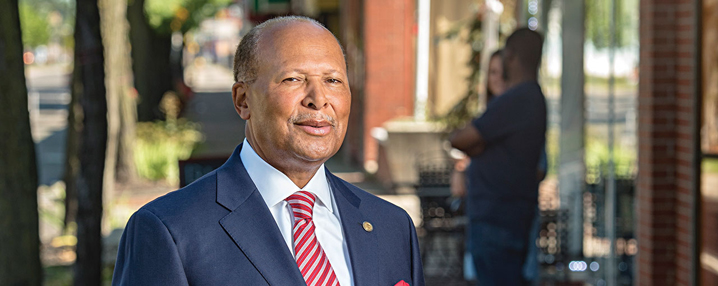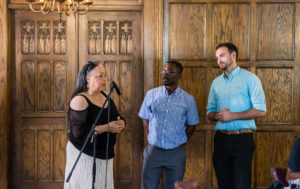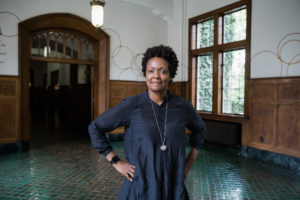Although he’s not a local native, Dr. Antoine Garibaldi is on familiar ground.
Hailing from New Orleans, the University of Detroit Mercy president has family in the Detroit area and a background of scholarship that supported black Michigan youth during the 1990s.
Today his ongoing challenge is to lead a campus of 5,000 in the Jesuit and Mercy academic traditions, while fulfilling a broader mission to improve the neighborhood beyond campus. With a unique position as Michigan’s largest Catholic university and one of two colleges in the Livernois-McNichols community on Detroit’s northwest side, Detroit Mercy can significantly influence the lives of both students and residents.

“I’ve seen neighborhoods come back in New Orleans,” he says, referencing 12 years since a hurricane devastated the Louisiana city. “It’s not 100 percent. It’s maybe 75 percent, depending on what neighborhood you go to. It’s not just houses. It’s population growth.”
As part of the Live6 Alliance, whose mission is to enhance life and economic opportunity in Northwest Detroit, specifically neighborhoods bordering Livernois Avenue and Six Mile (McNichols) Road, Detroit Mercy has financially invested in a similar growth vision. About 40 Detroit Mercy employees live in the University District, a stone’s throw from campus, Garibaldi says. Yet, in neighboring subdivisions, like Fitzgerald, vacant housing and unemployment have impacted residents since long before Garibaldi arrived six years ago.
Nonetheless, he’s optimistic.
“I’ve seen and lived in cities that were at their worst and came back,” Garibaldi says.
Along with Detroit Mercy’s long-standing programs, such as the low-cost psychology clinic based at its Livernois campus and its low-cost dental and legal clinics, all of which welcome the public, the college requires community involvement. Through its Institute for Leadership and Service about 1,500 students annually remove trash from the neighborhood, deliver food to shut-in seniors, and participate in other similar efforts. Garibaldi has joined students and faculty volunteers in their service.
Another initiative he supports is the recently renewed Michigan legislation to give campus police officers arresting authority in neighborhoods beyond Detroit Mercy’s property. As stated, Public Act 324 “permits a private college security officer, under certain circumstances, to have the same authority and power as a police officer, in order to enforce state and local laws.”
“You don’t want to go into neighborhoods thinking that you’re going to make things wonderful. You have to find out what the people want to see.” -Dr. Antoine Garibaldi, President, University of Detroit Mercy
For some, the re-enacted legislation raises concerns at a time when tension between law enforcement and citizens has increased nationwide due to widely publicized, often deadly, confrontations involving police officers. But Detroit Mercy’s 40-person police force is a safety asset to the community, the president says, despite the danger its officers might face, such as a Wayne State University officer killed while working off-campus last year.
“That’s one of the risks that we have to weigh,” says Garibaldi. “The purpose isn’t necessarily to apprehend, but to assist when we see things happen.”
In the past, Detroit Mercy officers have been limited even from responding to incidents at buildings like their own fraternity houses because of their location, he says. But in keeping with the Live6 Alliance’s philosophy, Garibaldi says the will of city residents must be respected.

“You don’t want to go into neighborhoods thinking that you’re going to make things wonderful. You have to find out what the people want to see,” he says.
To help Detroiters literally see more of the beauty and imagery they envision, the university’s Detroit Collaborative Design Center provides planning and design services and free consultation to non-profit and civic organizations. Even student athletes have coordinated interactions with the community, school administrators say.
“The cool thing about this place is that every single thing we do has some specific training, other than reading, writing, and books, that comes out of their experience being at an urban university,” says Gary J. Erwin, associate vice president of marketing and public affairs.
Still, a consistent hurdle for the college that charges about $42,000 in annual tuition for full-time undergrads is integrating cultures of more affluent, predominantly white young adults and black, working-class residents and businesses surrounding Detroit Mercy. Though 85 percent of its students are from Michigan, Erwin says it’s not uncommon to find parents reluctant to sign off on their son’s or daughter’s preference to live on a campus in the heart of the city.

Expanding housing is one administrative goal that would give Detroit Mercy students both security and positive community exposure. Lauren Hood, Live6 Alliance’s co-director, says direct engagement with residents is vital for both faculty and enrollees.
“I’m encouraged by the administration’s increased interest in Live6 neighborhood events,” Hood says.
The university hosted a “Speakeasy” dinner and dialogue series organized by the Alliance, but Hood says she’d love to see Garibaldi attend one of the monthly forums and hear from community members directly.
Garibaldi says he’ll keep working toward the time when accomplishments on and off campus are comparable.
“I will know when this is a destination place,” he says, “when students are coming for goods and services, when people are coming to live in this area, when businesses are not vacant, and when you see a much prettier picture of this community.”
He’s begun noticing a gradual increase in Live6 couples and Detroiters from other parts of the city.
“The job we all have,” says Garibaldi, “is to see that they stay.”
 See more of TheHUB’s coverage on District 2:
See more of TheHUB’s coverage on District 2:
More reasons to #LiveLoveDetroit
Making Magic: Former Fairgrounds is site of $1 billion vision
Citizens organize around former Fairgrounds’ future
Stop the presses: Fitzgerald project publicity must wait on results
Breaking Barriers: University strives to meld campus with community
Matchmaker: Motor City Match builds dreams in District 2 and citywide
A Sip of Success: Café aims to bring residents, students and businesses under one roof
Celebrating a Century: Sherwood Forest turns 100
Partners for Progress: Teamwork guides multi-million-dollar neighborhood fun
Lead photo: University of Detroit Mercy staff and faculty, including President Antoine Garibaldi, volunteer efforts to help beautify the Live6 community. Photo courtesy of University of Detroit Mercy


